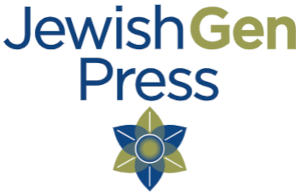

Published by the JewishGen Press
Available from
for $44.00
Original book Ayarati; sefer zikaron le-ayarot Dobrzynń-Golub
Editors: M. Harpaz and Editorial Committee: Y. Rosenwax, A. Dor and H. Lord
Published by the Association of Former Residents of Dobrzynń- Golub
Published in Tel Aviv, 1969
Cover Design: Rachel Kolokoff Hopper
Layout: Donni Magid
Hard Cover, 11” by 8.5”, 664 pages with all original illustrations and photographs.
Click here to see the index containing the family names in this book. If you already have purchased the book, please print out and insert into the back of the book.
 |
Details:
The Dobrzyn-Golub Yizkor Book evokes both pleasure and pain: pleasure from the nostalgic accounts by the Dobrzyn Jews who emigrated before World War II, and pain from the narratives describing the destruction of all traces of the town's rich Jewish culture. For beginning in 1939 its Jewish population was savagely expelled and murdered, all Jewish institutions were eradicated, and even the Jewish cemetery was obliterated.
This book contains chilling accounts by a handful of survivors who experienced the trauma of the Nazi occupation of the town, the mass-murder of leading Jewish citizens, and the expulsion to ghettos, work camps and death camps. Other essays on prewar personalities describe dreamers, poets, community organizers, scholars and noted rabbis. They tell the story of a multi-faceted prewar Jewish culture: the ardor of religious life and the advent of secular studies, socialism, Zionism, sports, and theatre. The town was home to all the warring Jewish factions of the period: the pious Hasidim; the secular socialists; and the Zionists, both secular and religious. Despite their sharp differences they would join hands to provide charity to the needy, and they would be as unified as a close family in the face of anti-Semitism.
The range of topics covered in these essays spans the entire gamut of Jewish experience in the town. There are the adventures of a Dobrzyn Jew in the Czar's army of 1910 and in a World-War I German work camp. There is a description of an election of town rabbi in which the two candidates are backed by vying Hasidic groups. A scholar living in New York who was raised in Dobrzyn writes how he still yearns for the simple life he led there. An ecstatic poem, written by an ascetic kabbalist who hailed from Dobrzyn, is filled with fury and religious awe. We meet a gabardine-clad Hasid who preaches Zionism to his pious fellow Hasidim as well as to sophisticated German Jews. And a Dobrzyner, recalling his childhood studies in cheder, tells of a prank played by the schoolchildren on their teacher, and the teacher's revenge. The essays also include postwar updates: descriptions and obituaries depicting the lives of those who settled in Israel; and accounts by American Dobrzyners of their landsmanshaft fundraising. There are photographs from Dobrzyn in the period 1910-1939, and others from Israel and the US up to the 1960s.
The essays by the American Dobrzyners were nearly all written in Yiddish; those authored by their Israeli counterparts were mostly in Hebrew. The entire set of essays, as well as a map of the town, appear here in English translation, with footnotes by the translator and a Holocaust necrology that has been extracted from the essays.
Alternate names: Golub-Dobrzyń [Pol], Dobrin bei Dervents [Yid], Dobrzyń nad Drwęcą [Pol], Dobrin an der Drewenz [Ger], Dobzhin nad Drvents, Gollub [Ger], Golub, Dobzhin, Dobzhin Golub, Dobrzyń-Golub, Golub Dobzhin
Golub-Dobrzyń, Poland is located at: 53°07' North Latitude, 19°03' East Longitude
|
 JewishGen Press
JewishGen Press
 JewishGen Home Page
JewishGen Home Page
Copyright © 1999-2025 by JewishGen, Inc.
Updated 15 Oct 2022 by LA